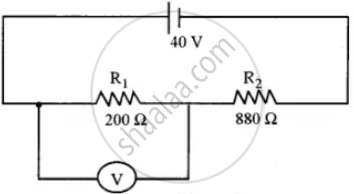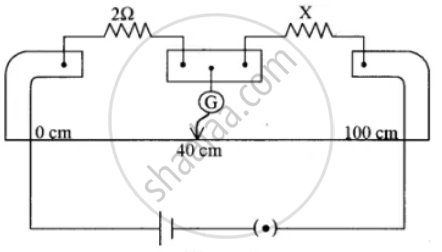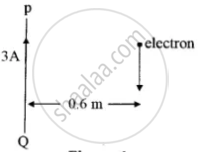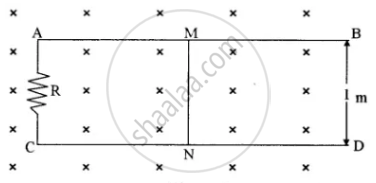ISC (Commerce)
ISC (Arts)
ISC (Science)
Academic Year: 2016-2017
Date & Time: 1st March 2017, 2:00 pm
Duration: 3h
Advertisements
Attempt all questions are compulsory.
The electrostatic potential energy of two-point charges, 1 µC each, placed 1 meter apart in the air is:
9 ×103 J
9 ×109J
9 ×10-3 J
9 ×10-3 eV
Chapter: [0.012] Electrostatic Potential, Potential Energy and Capacitance
A wire of resistance 'R' is cut into 'n' equal parts. These parts are then connected in parallel with each other. The equivalent resistance of the combination is :
nR
R/n
n/R2
R/n2
Chapter: [0.012] Electrostatic Potential, Potential Energy and Capacitance
The magnetic susceptibility of platinum is 0.0001. It's relative permeability is:
1.0000
0.9999
1.0001
0
Chapter: [0.032] Magnetism and Matter
When a light wave travels from air to glass
its wavelength decreases.
its wavelength increases.
there is no change in wavelength.
its frequency decreases.
Chapter: [0.07] Dual Nature of Radiation and Matter
A radioactive substance decays to 1/16th of its initial mass in 40 days. The half-life of the substance, in days, is:
20
10
5
2.5
Chapter: [0.08199999999999999] Nuclei
Maximum torque acting on an electric dipole of moment 3×10-29 Cm in a uniform electric field E is 6 × 10-25 Nm. Find E.
Chapter: [0.011000000000000001] Electric Charges and Fields
What is meant by the drift speed of free electrons?
Chapter: [0.02] Current Electricity
On which conservation principle is Kirchoff's Second Law of electrical networks based?
Chapter: [0.02] Current Electricity
Calculate magnetic flux density of the magnetic field at the centre of a circular coil of 50 turns, having a radius of 0.5m and carrying a current of 5 A.
Chapter: [0.040999999999999995] Electromagnetic Induction
An a.c generator generates an emf 'ε' where ε = 314 Sin (50πt) volt. Calculate the frequency of emf ε.
Chapter: [0.042] Alternating Current
With what type of source of light are cylindrical wave fronts associated?
Chapter: [0.062] Wave Optics
How is the fringe width of an interference pattern in Young's double-slit experiment affected if the two slits are brought closer to each other?
Chapter: [0.062] Wave Optics
In a regular prism, what is the relation between angle of incidence and angle of emergence when it is in the minimum deviation position?
Chapter: [0.061] Ray Optics and Optical Instruments
A converging lens of focal length 40 cm is kept in contact with a diverging lens of focal length 30 cm. Find the focal length of the combination .
Chapter: [0.061] Ray Optics and Optical Instruments
How can the spherical aberration produced by a lens be minimized?
Chapter: [0.061] Ray Optics and Optical Instruments
Calculate the momentum of a photon of energy 6 x I 0-19 J.
Chapter: [0.07] Dual Nature of Radiation and Matter
According to Bohr, 'Angular momentum of an orbiting electron is quantized'. What is meant by this statement?
Chapter: [0.081] Atoms
Why nuclear fusion reaction is also called thermo-nuclear reaction?
Chapter: [0.08199999999999999] Nuclei
What is the minimum energy which a gamma-ray photon must possess in order to produce electron-positron pair?
Chapter: [0.08199999999999999] Nuclei
Show the variation of voltage with time, for a digital signal.
Chapter: [0.09] Electronic Devices
Show that electric potential at a point P, at a distance 'r' from a fixed point charge Q, is given by:
`v=(1/(4pi∈_0))Q/r`.
Chapter: [0.012] Electrostatic Potential, Potential Energy and Capacitance
Advertisements
The intensity of the electric field at a perpendicular distance of 0·5 m from an infinitely long line charge having linear charge density (λ) is 3-6 × 103 Vm-1. Find the value of λ.
Chapter: [0.011000000000000001] Electric Charges and Fields
Three capacitors C1 = 3μF, C2 = 6μF, and C3 = 10μF are connected to a 50 V battery as shown in Figure below:

Calculate:
(i) The equivalent capacitance of the circuit between points A and B.
(ii) The charge on C1.
Chapter: [0.012] Electrostatic Potential, Potential Energy and Capacitance
Two resistors R1= 60 Ω and R2 = 90Ω are connected in parallel. If electric power consumed by the resistor R1 is15 W, calculate the power consumed by the resistor R2.
Chapter: [0.02] Current Electricity
Figure below shows two resistors R1 and R2 connected to a battery having an emf of 40V and negligible internal resistance. A voltmeter having a resistance of. 300 Ω is used to measure the potential difference across R1 Find the reading of the voltmeter.

Chapter: [0.02] Current Electricity
A moving coil galvanometer has a coil of resistance 59 Ω. It shows a full-scale deflection for a current of 50 mA. How will you convert it to an ammeter having a range of 0 to 3A?
Chapter: [0.031] Moving Charges and Magnetism
In a meter bridge circuit, resistance in the left-hand gap is 2 Ω and an unknown resistance X is in the right-hand gap as shown in the figure below. The null point is found to be 40 cm from the left end of the Wire. What resistance should be connected to X so that the new null point is 50 cm from the left end of the wire?

Chapter: [0.02] Current Electricity
The horizontal component of the earth's magnetic field at a place is `1/sqrt(3)` time the vertical component. Determine the angle of dip at that place.
Chapter: [0.032] Magnetism and Matter
Using Ampere's circuital law, obtain an expression for the magnetic flux density 'B' at a point 'X' at a perpendicular distance 'r' from a long current-carrying conductor.
(Statement of the law is not required).
Chapter: [0.031] Moving Charges and Magnetism
PQ is a long straight conductor carrying a current of 3A as shown in Figure below. An electron moves with a velocity of 2 x 107 ms-1 parallel to it. Find the force acting on the electron.

Chapter: [0.031] Moving Charges and Magnetism [0.032] Magnetism and Matter
AB and CD are two parallel conductors kept 1 m apart and connected by a resistance R of 6 Ω as shown in Figure below. They are placed in a magnetic field B = 3 × 10-2 T which is perpendicular to the plane of the conductors and directed into the paper. A Wire. MN is placed over AB and CD. and then made to slide with a velocity 2 ms-1 (Neglect the resistance of AB, CD, and MN.)

Calculate the induced c.urrent flowing through the resistor R.
Chapter: [0.012] Electrostatic Potential, Potential Energy and Capacitance
In an ideal transformer, an output of 66 kV is required when an input voltage of 220 V is available. If the primary has 300 turns, how many turns should the secondary have?
Chapter: [0.042] Alternating Current
In a series, LCR circuit, obtain an expression for the resonant frequency,
Chapter: [0.042] Alternating Current
State any one property which is common to all electromagnetic waves.
Chapter: [0.05] Electromagnetic Waves
Arrange the following electromagnetic waves in increasing order of their frequencies (i.e. begin with the lowest frequency):
Visible light, y rays, X rays, microwaves, radio waves, infrared radiations, and ultraviolet radiation.
Chapter: [0.05] Electromagnetic Waves
What is meant by diffraction of light?
Chapter: [0.07] Dual Nature of Radiation and Matter
In Fraunhofer diffraction, what kind of a source of light is used and where is it situated?
Chapter: [0.062] Wave Optics
Advertisements
In Young's double slit experiment using monochromatic light of wavelength 600 nm, 5th bright fringe is at a distance of 0·48 mm from the centre of the pattern. If the screen is at a distance of 80 cm from the plane of the two slits, calculate:
(i) Distance between the two slits.
(ii) Fringe width, i.e. fringe separation.
Chapter: [0.062] Wave Optics
(i) State Brewster's law.
(ii) Find Brewster's angle for a transparent liquid having refractive index 1·5.
Chapter: [0.062] Wave Optics
Find a critical angle for glass and water pair, given the refractive index of glass, is 1 ·62 and that of water is 1 ·33.
Chapter: [0.061] Ray Optics and Optical Instruments
Starting with an expression for refraction at a single spherical surface, obtain Lens Maker's Formula.
Chapter:
compound microscope consists of two convex lenses of focal length 2 cm and 5 cm. When an object is kept at a distance of 2.1 cm from the objective, a virtual and magnified image is fonned 25 cm from the eye piece. Calculate the magnifying power of the microscope.
Chapter: [0.061] Ray Optics and Optical Instruments
(i) What is meant by resolving power of a telescope?
(ii) State any one method of increasing the resolving power of an astronomical telescope.
Chapter: [0.061] Ray Optics and Optical Instruments
Plot a labelled graph of IVsl where Vs is stopping potential versus frequency f of the incident radiation.
Chapter: [0.07] Dual Nature of Radiation and Matter
State how will you use this graph to detennine the value of Planck's constant.
Chapter: [0.07] Dual Nature of Radiation and Matter
Find the de Broglie wavelength of electrons moving with a speed of 7 × 106 ms -1.
Chapter: [0.07] Dual Nature of Radiation and Matter
Describe in brief what is observed when moving electrons are allowed to fall on a thin graphite film and the emergent beam falls on a fluorescent screen.
Chapter: [0.07] Dual Nature of Radiation and Matter
Draw energy level diagram for a hydrogen atom, showing the first four energy levels corresponding to n=1, 2, 3 and 4. Show transitions responsible for:
(i) Absorption spectrum of Lyman series.
(ii) The emission spectrum of the Balmer series.
Chapter: [0.081] Atoms
(i) Find the maximum frequency of X-rays produced by an X-ray tube operating at a tube potential of 66 kV.
(ii) State any one difference between characteristic X-rays and continuous X-rays.
Chapter: [0.07] Dual Nature of Radiation and Matter
Obtain a relation between the half-life of a radioactive substance and decay constant (λ).
Chapter: [0.08199999999999999] Nuclei
Calculate mass defect and binding energy per nucleon of `"_10^20 Ne`, given
Mass of `"_10^20 Ne= 19.992397` u
Mass of `"_0^1H = 1.007825` u
Mass of `"_0^1n = 1.008665` u
Chapter: [0.08199999999999999] Nuclei
With reference to a semiconductor diode, what is meant by:
(i) Forward bias
(ii) Reverse bias
(iii) Depletion region
Chapter: [0.09] Electronic Devices
Draw a diagram to show how NAND gates can be combined to obtain an OR gate. (Truth table is not, required)
Useful Constants and Relations:
| 1. | Charge of a proton | (e) | =1.6 × 10-19C |
| 2. | Planck's constant | (h) | = 6·6 × 10-34 Js |
| 3. | Mass of an electron | (m) | = 9·1× 10-31 kg |
| 4. | Permittivity of vacuum | (∈0) | =8 · 85 × 10-12 Fm-1 |
| 5. | `(1/(4pi∈_0))` | =9 ×109 mF-1 | |
| 6. | Permeability of vacuum | (μ0) | = 4π × 10-7 Hm-1 |
| 7. | `((mu_0)/(4pi))` | =1 × 10-7 Hm-1 | |
| 8. | Speed of light in vacuum | (c) | = 3× 108 ms-1 |
| 9. | Unified atomic mass unit | (u) |
= 931 MeV |
| 10. | Electron volt | (leV) | = 1.6 × 10-19 J |
Chapter: [0.09] Electronic Devices
Submit Question Paper
Help us maintain new question papers on Shaalaa.com, so we can continue to help studentsonly jpg, png and pdf files
CISCE previous year question papers Class 12 Physics (Theory) with solutions 2016 - 2017
Previous year Question paper for CISCE Class 12 -2017 is solved by experts. Solved question papers gives you the chance to check yourself after your mock test.
By referring the question paper Solutions for Physics (Theory), you can scale your preparation level and work on your weak areas. It will also help the candidates in developing the time-management skills. Practice makes perfect, and there is no better way to practice than to attempt previous year question paper solutions of CISCE Class 12.
How CISCE Class 12 Question Paper solutions Help Students ?
• Question paper solutions for Physics (Theory) will helps students to prepare for exam.
• Question paper with answer will boost students confidence in exam time and also give you an idea About the important questions and topics to be prepared for the board exam.
• For finding solution of question papers no need to refer so multiple sources like textbook or guides.
